Five Stans Discovery
26 Days Private Tour of Almaty - Saty - Jeti-Oguz - Skazka Canyon - Bokonbayevo - Burana Tower - Bishkek - Tashkent - Khujand - Istaravshan - Panjakent - Seven Lakes - Iskanderkul - Dushanbe - Kalai-Khumb - Termez - Samarkand - Bukhara - Mary - Ashgabat - Darvaza - Khiva - Tashkent
Tour Type: Private guided tour, flexible and customizable
Transportation: Comfortable air-conditioned private car with driver
Accommodation: 3 to 4-star hotels & guesthouses, open to your own choice
Meals: 25 breakfasts, 4 lunches, 5 dinners
Code: TCA108
Transportation: Comfortable air-conditioned private car with driver
Accommodation: 3 to 4-star hotels & guesthouses, open to your own choice
Meals: 25 breakfasts, 4 lunches, 5 dinners
Code: TCA108
This trip can be customized to meet your individual needs!
Free InquiryGet our reply within 24 hours!
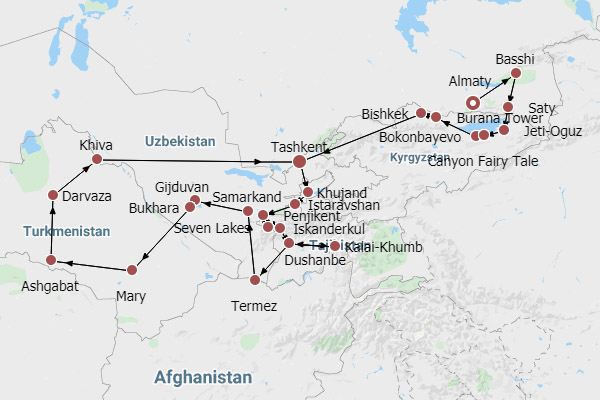
- Itinerary
- Reviews
Trip Highlights
- Admire the weird rock formations at Charyn Canyon National Park in Kazakhstan.
- Escape to the green wildness of Kyrgyzstan to soothe your soul hiking in the Ala Archa National Park.
- Witness the eagle-hunting process and take pictures with raptors at Bokonbayevo Village in Kyrgyzstan.
- Venture along the epic M41 Pamir Highway and enjoy the jagged ridges and stark plateau scenery.
- Unveil secret legends that happened on the Silk Road by viewing the grand Samarkand and UNESCO-listed Khiva.
- Capture the flaming Darvaza Gas Crater and enjoy a BBQ dinner under the starry sky in Turkmenistan.
Expand All
Collapse All
Day 1 Arrival in Almaty, Kazakhstan; Airport Pick-up
Ready for the nearly one-month Central Asia tours to five stans countries? We will commence the journey in Kazakhstan, the world’s largest landlocked country. Spanning Eurasia, it boasts diverse landscapes, ranging from expansive steppes and towering mountain ranges to pristine alpine lakes.
Upon landing in the country's largest city, Almaty, our driver guide will pick you up and transfer you to the pre-booked hotel. You can have a rest to get over the jet lag or hang around on your own to view landmarks like the Zenkov Cathedral or take a cable car (KZT 8,000 / USD 15 for a round-trip) to the top of Kok Tobe Hill for a sweeping view of the city, located at the foot of majestic snow-capped mountains.
 Things to be Prepared:
Things to be Prepared:
1. Currency & Payments: Cash still dominates throughout the five countries, while cards are rarely accepted outside upscale hotels and restaurants. It is convenient to find and exchange cash at ATMs, except in Turkmenistan. Please note that most of the machines can withdraw money with Visa, and several accept Mastercard.
2. Mobile Connectivity: Apart from purchasing SIM cards at mobile outlets after arriving, buying an Airalo e-SIM card online ahead of time is another good choice. It offers coverage for four countries, except for Turkmenistan. Please note that mobile network coverage is limited across all five countries, particularly in remote areas, like deserts and high-altitude regions, where there are no signals.
3. Plug Converter: All five countries utilize the Type C or Type F electrical outlets, so please pack a plug adapter if needed. Additionally, we recommend bringing a portable power bank in case the battery runs out.
Accommodation: Renion Park Hotel, Almaty (3 stars) or similar
Upon landing in the country's largest city, Almaty, our driver guide will pick you up and transfer you to the pre-booked hotel. You can have a rest to get over the jet lag or hang around on your own to view landmarks like the Zenkov Cathedral or take a cable car (KZT 8,000 / USD 15 for a round-trip) to the top of Kok Tobe Hill for a sweeping view of the city, located at the foot of majestic snow-capped mountains.
1. Currency & Payments: Cash still dominates throughout the five countries, while cards are rarely accepted outside upscale hotels and restaurants. It is convenient to find and exchange cash at ATMs, except in Turkmenistan. Please note that most of the machines can withdraw money with Visa, and several accept Mastercard.
2. Mobile Connectivity: Apart from purchasing SIM cards at mobile outlets after arriving, buying an Airalo e-SIM card online ahead of time is another good choice. It offers coverage for four countries, except for Turkmenistan. Please note that mobile network coverage is limited across all five countries, particularly in remote areas, like deserts and high-altitude regions, where there are no signals.
3. Plug Converter: All five countries utilize the Type C or Type F electrical outlets, so please pack a plug adapter if needed. Additionally, we recommend bringing a portable power bank in case the battery runs out.
Accommodation: Renion Park Hotel, Almaty (3 stars) or similar
Day 2 Almaty: Almaty Museum, Ascension Cathedral, Green Bazaar, Medeu Gorge, Kok-Tobe Hill Sunset
The jumping-off point of today’s Almaty sightseeing is the Almaty Museum, a repository that records the past stories of the city. The eleven rooms showcase the city’s history from ancient to modern times, through displaying artworks, traditional customs, weapons, and related pictures. Getting out of the museum, let’s step into the shaded walkways of the Park of 28 Panfilov Guardsmen. Just like its name, the park was built to commemorate 28 soldiers who sacrificed in the war to safeguard Moscow from the invasion of the Nazis. Today, it serves as both a memorial site and a popular leisure destination for locals. From afar, the radiance of the golden top of the Ascension Cathedral (Zenkov Cathedral), piercing through the canopies, will beckon you. This building is one of the few structures that survived the 1911 megaseism. As a landmark of Almaty, its amber-colored façade and emerald eaves are quite photogenic.
Then, head to the Green Bazaar (Zeleny Bazar), the most exuberant gathering place reflecting the daily life of locals. The stalls, overwhelmed with colorful vegetables and pink meat, resemble palettes. As you explore deeper, your nose will be generally filled with the aroma of pungent spices and sweet succades. After calming down from the noise of the market, the driver guide will accompany you to escape to the Medeu Gorge, located in the outer suburbs of the city, where you will take a cable car to the Shymbulak Ski Resort, one of the world’s highest skiing rinks, to overlook the panoramic view of the valley and the Heavenly Mountain in the distance. Before dusk, you will be transferred back to the city and ascend the Kok-Tobe Hill by an electric bus, to admire the sunset view of Almaty. As the sunlight becomes soft, the skyline of the city generally sinks into a golden hue, offering a chance to capture the silhouette of the city with a backdrop against an orange sky.
Meals: Breakfast
Accommodation: Renion Park Hotel, Almaty (3 stars) or similar
Then, head to the Green Bazaar (Zeleny Bazar), the most exuberant gathering place reflecting the daily life of locals. The stalls, overwhelmed with colorful vegetables and pink meat, resemble palettes. As you explore deeper, your nose will be generally filled with the aroma of pungent spices and sweet succades. After calming down from the noise of the market, the driver guide will accompany you to escape to the Medeu Gorge, located in the outer suburbs of the city, where you will take a cable car to the Shymbulak Ski Resort, one of the world’s highest skiing rinks, to overlook the panoramic view of the valley and the Heavenly Mountain in the distance. Before dusk, you will be transferred back to the city and ascend the Kok-Tobe Hill by an electric bus, to admire the sunset view of Almaty. As the sunlight becomes soft, the skyline of the city generally sinks into a golden hue, offering a chance to capture the silhouette of the city with a backdrop against an orange sky.
Meals: Breakfast
Accommodation: Renion Park Hotel, Almaty (3 stars) or similar
Day 3 Almaty - Charyn Canyon National Park (Valley of Castles) - Saty Village
Set off from Almaty, and a 3-hour drive will lead you to the most majestic part of the Charyn Canyon National Park, the Valley of Castles. Carved over 12 million years, the gorge appears as a colossal fissure torn through the heart of the steppe. Sheer cliffs flank the canyon, revealing striated layers of vibrant red rock that create an astonishingly Martian-like vista. Depending on your physical condition, you can hike in the canyon for an immersive experience or be driven directly to the viewpoint to gaze upon the breathtaking panorama of the “Grand Canyon’s little brother.” As dusk approaches, the rocks are bathed in the radiant golden light of the setting sun, with the backdrop against the pink and purple twilight clouds. Wearing brightly colored clothing or denim will make you stand out against the red rocks for exceptional photos. You can also linger over coffee at the café near the entrance for a short break.
Afterwards, leaving the canyon behind, our driver guide will escort you to the Saty Village, nestled in a valley. Check into the well-selected hotel and have a good rest to prepare for tomorrow’s adventures.
►Tips for Your Natural Exploration
1. On this 27-day trip, we'll explore several natural parks and hike to alpine lakes, so please pack a pair of comfy and sturdy shoes. Long-sleeved shirts and pants are necessary because the temperature in the mountains varies. Deserts and plateaus are also included in the itinerary, where the temperature can soar up to 40°C (104°F) from May to August. Hence, sun-protective gear is essential. Masks are needed in case of occasional dust storms. Additionally, it is recommended that you bring some snacks and bottled water, as there are no shops available at most natural sites.
2. Road conditions in the "five stans" are quite limited. To alleviate car sickness, it is wise to prepare some Dramamine.
3. There may be no mobile signal in national parks or deserts, so please follow our private guide closely.
Meals: Breakfast, Lunch, Dinner
Accommodation: Saty Village guest house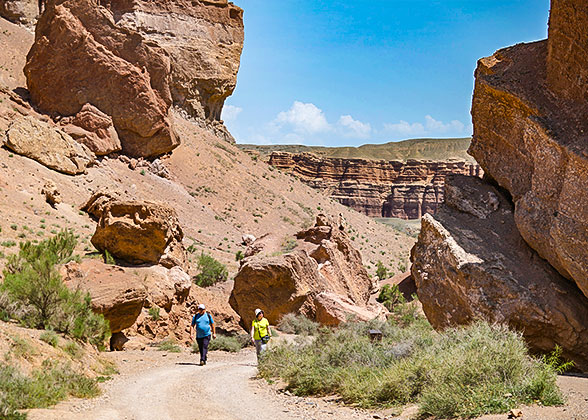
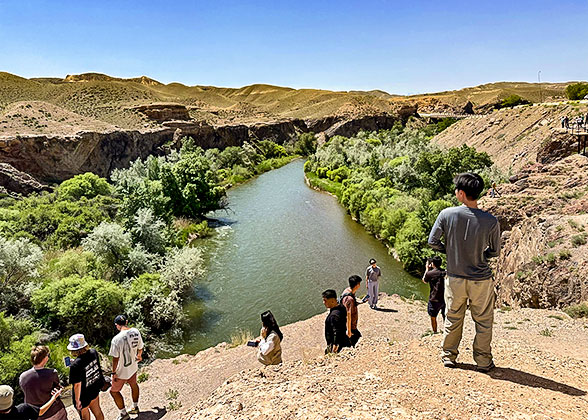
Afterwards, leaving the canyon behind, our driver guide will escort you to the Saty Village, nestled in a valley. Check into the well-selected hotel and have a good rest to prepare for tomorrow’s adventures.
►Tips for Your Natural Exploration
1. On this 27-day trip, we'll explore several natural parks and hike to alpine lakes, so please pack a pair of comfy and sturdy shoes. Long-sleeved shirts and pants are necessary because the temperature in the mountains varies. Deserts and plateaus are also included in the itinerary, where the temperature can soar up to 40°C (104°F) from May to August. Hence, sun-protective gear is essential. Masks are needed in case of occasional dust storms. Additionally, it is recommended that you bring some snacks and bottled water, as there are no shops available at most natural sites.
2. Road conditions in the "five stans" are quite limited. To alleviate car sickness, it is wise to prepare some Dramamine.
3. There may be no mobile signal in national parks or deserts, so please follow our private guide closely.
Meals: Breakfast, Lunch, Dinner
Accommodation: Saty Village guest house

Charyn Canyon National Park, Kazakhstan

Enjoy the Canyon in Kazakhstan
Day 4 Saty Village - Lower Kolsai Lake - Kaindy Lake - Saty Village
Setting off from the Saty Village after breakfast, you will be conveyed to the Kolsai Lakes. Composed of Lower, Middle, and Higher Lakes, it is a stunning trio of alpine lakes. We will focus on the Lower Kolsai Lake today. As the most popular lake among the three, it has a surface resembling a sapphire encircled by dense fir forests. Stroll along the shore, you might spot translucent alpine salamanders hiding among the pebbles. A sudden encounter with a pungent, earthy smell signals the presence of ibex! Stay observant, and you may see these creatures grazing or drinking near the lake. Glance upwards, and the glaciers of the Kungey Alatau range shimmer with a distinctive steel-blue radiance under the sun.
 For Your Information:
For Your Information:
1. Please carry your passport, since the Kolsai Lakes are close to the Kazakhstan-Kyrgyzstan border, where you may encounter border patrols to check your identification.
2. Summer (June-September) is the best time to visit, offering full lakes, lush vegetation, and accessible trails. However, during autumn (October-November) and spring (April-May), the lakes may be frozen, and hiking trails may be covered by snow or ice.
3. Kolsai Lakes are a paradise for hiking. If interested, we can tailor the itinerary for you to include a 5-6-hour scenic hike from the Lower to the Middle Kolsai Lake, with a round-trip distance of 11-12 kilometers (6.8-7.5 miles), rising from roughly 2,252 to 2,850 meters (7,400-9,350 feet) in elevation. If you don’t feel like hiking, horseback riding is available from April to October, costing KZT 16,000-21,000 (USD 30-40) per person at your own expense for a round trip.
Afterward, we will continue to the Kaindy Lake. Due to the limited road conditions, our vehicle cannot reach the shore directly, and you will need to walk for a while after disembarking. Over its cobalt blue surface stand the stark trunks of submerged spruce trees like the masts of ghostly ships. This surreal landscape was formed over a century ago when a powerful earthquake triggered a massive landslide, trapping meltwater, and the once-thriving spruce forest was flooded, becoming a sunken forest. Peering into the clear water, you can still observe these ancient trees almost exactly as they were when the floodwaters engulfed them. At the end of the day, we will return to Saty Village.
Meals: Breakfast, Lunch, Dinner
Accommodation: Saty Village guest house
1. Please carry your passport, since the Kolsai Lakes are close to the Kazakhstan-Kyrgyzstan border, where you may encounter border patrols to check your identification.
2. Summer (June-September) is the best time to visit, offering full lakes, lush vegetation, and accessible trails. However, during autumn (October-November) and spring (April-May), the lakes may be frozen, and hiking trails may be covered by snow or ice.
3. Kolsai Lakes are a paradise for hiking. If interested, we can tailor the itinerary for you to include a 5-6-hour scenic hike from the Lower to the Middle Kolsai Lake, with a round-trip distance of 11-12 kilometers (6.8-7.5 miles), rising from roughly 2,252 to 2,850 meters (7,400-9,350 feet) in elevation. If you don’t feel like hiking, horseback riding is available from April to October, costing KZT 16,000-21,000 (USD 30-40) per person at your own expense for a round trip.
Afterward, we will continue to the Kaindy Lake. Due to the limited road conditions, our vehicle cannot reach the shore directly, and you will need to walk for a while after disembarking. Over its cobalt blue surface stand the stark trunks of submerged spruce trees like the masts of ghostly ships. This surreal landscape was formed over a century ago when a powerful earthquake triggered a massive landslide, trapping meltwater, and the once-thriving spruce forest was flooded, becoming a sunken forest. Peering into the clear water, you can still observe these ancient trees almost exactly as they were when the floodwaters engulfed them. At the end of the day, we will return to Saty Village.
Meals: Breakfast, Lunch, Dinner
Accommodation: Saty Village guest house
Day 5 Saty Village - Karkyra Border Crossing - Karakol, Kyrgyzstan
After breakfast, the driver guide will escort you to the Kazakh-Kyrgyz border. After completing immigration formalities, you’ll be welcomed by our Kyrgyz guide and the driver to the town of Karakol for hotel check-in.
 Recommended Food: Ashlan-Fu
Recommended Food: Ashlan-Fu
For a true local specialty to delight your palate, try Ashlan-Fu. It is a beloved traditional cold noodles of Kyrgyzstan, particularly popular in summer for its refreshing and tangy flavors. It features a base of chewy wheat starch and stretchy noodles, typically topped with a spicy and sour broth made from vinegar, chili oil, and various spices. It is often garnished with fresh herbs, sliced cucumbers, and scrambled eggs, creating a harmonious blend of textures and tastes. You can easily find Ashlan-Fu at local restaurants and market stalls for less than USD 1 per bowl.
Meals: Breakfast
Accommodation: Green Yard Hotel, Karakol (3 stars) or similar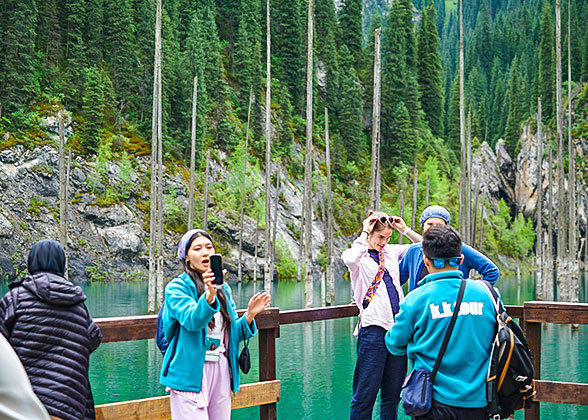
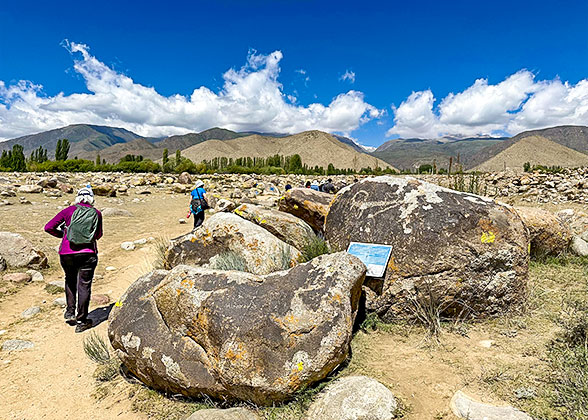
For a true local specialty to delight your palate, try Ashlan-Fu. It is a beloved traditional cold noodles of Kyrgyzstan, particularly popular in summer for its refreshing and tangy flavors. It features a base of chewy wheat starch and stretchy noodles, typically topped with a spicy and sour broth made from vinegar, chili oil, and various spices. It is often garnished with fresh herbs, sliced cucumbers, and scrambled eggs, creating a harmonious blend of textures and tastes. You can easily find Ashlan-Fu at local restaurants and market stalls for less than USD 1 per bowl.
Meals: Breakfast
Accommodation: Green Yard Hotel, Karakol (3 stars) or similar

Kaindy Lake

Scenery by the Issyk Kul Lake Shore, Kyrgyzstan
Day 6 Karakol City Tour; Jeti-Oguz Canyon & Skazka Canyon on the Southern Shore of Issyk-Kul Lake
We will briefly explore Karakol in the morning. First, head to the Holy Trinity Cathedral, a Russian-style building with emerald roofs and a dark brown wooden façade. Constructed in 1895, it once served as a school, a theater, and a coal bunker. The structure you can see now was rebuilt after the severe damage in a 20th-century earthquake. Then, the silhouette of the Dungan Mosque will come into view after a short walk eastward. Built in 1910 by Chinese Muslim refugees, now known as the Dungan People, it was assembled entirely without nails. Step inside the prayer hall to discover intricate carvings and paintings of the Chinese dragon and phoenix, which are symbols of luck, prosperity, and auspiciousness.
If you happen to visit Karakol on Sunday, just explore the vibrant animal market. The scent of hay and dust pervades the air, and the bleat of sheep and cattle mingles with the local herders’ hawking, offering a glimpse into genuine daily life.
Leaving Karakol, let’s head to the Jeti-Oguz Canyon on the southern shore of Lake Issyk-Kul, which looks like seven bulls from afar; hence, it is also named "Seven Bulls." Legend holds that the red color of the rock is from the blood of a man who perished in a duel with his rival in love. Continue westward, and Skazka Canyon (Canyon Fairy Tale) appears. Here, sandstones are eroded by the wind and water into fantastical shapes, such as crumbling ramparts and whimsical castle towers. Ascending to the lower viewpoint, you can capture a panoramic vista where the jagged formations create a "devil's city" landscape. For those seeking a broader perspective, a hike to the high viewpoint of layered rocks and hills will offer a more diverse geological image. Tonight, we’ll stay at the yurt located on the shore of Lake Issyk-Kul.
Meals: Breakfast
Accommodation: Nomad Lodge Tamga
If you happen to visit Karakol on Sunday, just explore the vibrant animal market. The scent of hay and dust pervades the air, and the bleat of sheep and cattle mingles with the local herders’ hawking, offering a glimpse into genuine daily life.
Leaving Karakol, let’s head to the Jeti-Oguz Canyon on the southern shore of Lake Issyk-Kul, which looks like seven bulls from afar; hence, it is also named "Seven Bulls." Legend holds that the red color of the rock is from the blood of a man who perished in a duel with his rival in love. Continue westward, and Skazka Canyon (Canyon Fairy Tale) appears. Here, sandstones are eroded by the wind and water into fantastical shapes, such as crumbling ramparts and whimsical castle towers. Ascending to the lower viewpoint, you can capture a panoramic vista where the jagged formations create a "devil's city" landscape. For those seeking a broader perspective, a hike to the high viewpoint of layered rocks and hills will offer a more diverse geological image. Tonight, we’ll stay at the yurt located on the shore of Lake Issyk-Kul.
Meals: Breakfast
Accommodation: Nomad Lodge Tamga
Day 7 Tamga - Bokonbayevo Village (Watch Eagle Hunting) - Burana Tower - Bishkek
★ Explore Eagle Hunting Culture at Bokonbayevo
After breakfast, the guide and the driver will transfer you to Bokonbayevo, a small town nestled on the southern shore of Lake Issyk-Kul. Removed from the urban area, it retains a relatively untouched nature, which preserves the ancient tradition of eagle hunting. During October and February, you may have a chance to witness the hunting process, which is hard to see in the molting season of eagles between March and September. The hunter releases the eagle, and the bird soars, circles to pinpoint the target, and dives to dispatch the quarry with its talons and snout. For a memorable experience, you can have an eagle perch on your arm for photographs, with the hunter’s permission.Afterward, we will proceed to Kyzyl-Tuu Village to observe the intricate construction process of the traditional Kyrgyz yurt. Generally, it takes 2-3 months to prepare the timbers, but the construction needs only 30 minutes. First, set up the wooden lattice-like walls and attach the door and the roof. Then, cover the framework with felt. The yurt will be complete after laying out the mats and hanging the tapestries.
In the afternoon, we will continue northwestward to the Burana Tower, the only surviving structure of Balasagun, the ancient capital of the Karakhanid dynasty (999-1211). Originally soaring 45 meters (148 feet), it was destroyed in an earthquake in the 15th century, leaving the present 25-meter (82-foot) tower standing on the land. You can climb the dark, narrow, and steep spiral staircases to the top for a panoramic view of the surrounding steppe. Near the tower, there are some Turkic balbal stone figures, which are said to commemorate the deceased.
Finally, you’ll be transferred to Bishkek, the capital of Kyrgyzstan, to check into the hotel. Just have a good rest and prepare for tomorrow’s hiking adventure.
Meals: Breakfast
Accommodation: Ramada by Wyndham Bishkek Centre (4 stars) or similar
Day 8 3-4 Hours’ Hike in Ala Archa National Park; Fly to Tashkent, Uzbekistan
Together with our guide and the driver, you’ll set foot on the unspoiled land of Ala Archa National Park, located in the range of the Heavenly Mountains. Following the paths covered with pine needles, we will pass through the dense forest, listening to the roar of the melting water streams, and finally stop at the Broken Heart rock formation, where you can see a 360-degree view of the valley. A round-trip hike covers 8-10 kilometers (5-6 miles) and typically takes 3-4 hours to complete.
Afterward, you’ll be transferred to the Bishkek Airport to catch a 1.5-hour flight to Tashkent, Uzbekistan. Upon landing, our Uzbekistan driver will meet you at the exit and escort you to the hotel for check-in.
 Uzbekistan Visa Requirement
Uzbekistan Visa Requirement
As this itinerary involves multiple entries into Uzbekistan, visitors from 50 countries, including most Americans, need to apply for a multi-entry visa. US citizens aged under 16 and over 55, as well as those from the EU and 66 other countries, including the UK, Canada, and New Zealand, are eligible for visa-free entry.
Meals: Breakfast
Accommodation: Wyndham Tashkent (4 stars) or similar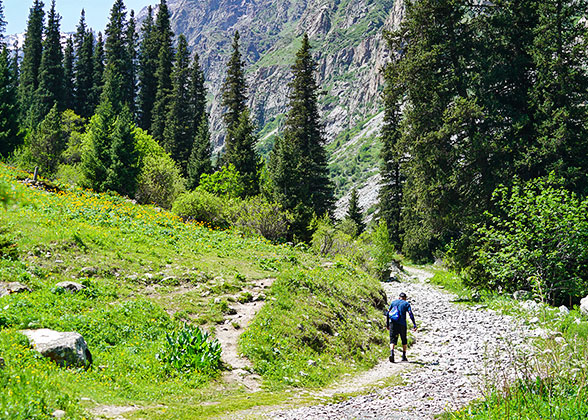
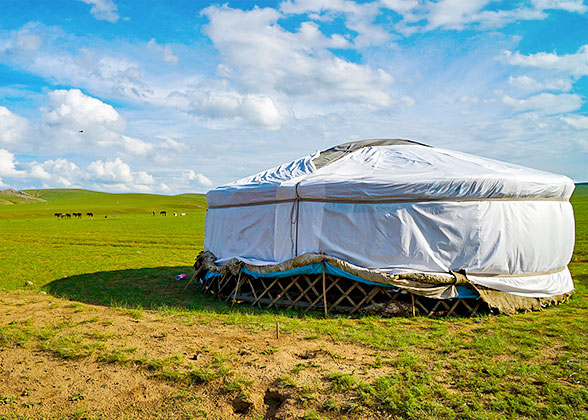
Afterward, you’ll be transferred to the Bishkek Airport to catch a 1.5-hour flight to Tashkent, Uzbekistan. Upon landing, our Uzbekistan driver will meet you at the exit and escort you to the hotel for check-in.
As this itinerary involves multiple entries into Uzbekistan, visitors from 50 countries, including most Americans, need to apply for a multi-entry visa. US citizens aged under 16 and over 55, as well as those from the EU and 66 other countries, including the UK, Canada, and New Zealand, are eligible for visa-free entry.
Meals: Breakfast
Accommodation: Wyndham Tashkent (4 stars) or similar

Ala Archa National Park, Bishkek

Kyrgyz Yurt
Day 9 Tashkent of Uzbekistan to Khujand of Tajikistan; Khujand City Tour
Set off from Tashkent in the morning, and the driver will accompany you on a 3-hour drive to the Uzbek-Tajik border, where our Tajik guide and the driver will meet you and escort you to the ancient city of Khujand. Thriving as a vital hub on the Silk Road, the city is a coveted prize for conquerors. In 329 BC, Alexander the Great established his northernmost outpost in Central Asia here. Nowadays, the remnants, including fortresses, bustling bazaars, and sacred mausoleums, await your exploration.
The guide will first lead you to the Historical Local Lore Museum of Archeology and Fortification housed within Khujand's 10th-century fortress to decode the secrets of the Sogdians, an ethnic group skilled in commerce that flourished from the 4th to the 8th centuries. You can find the ancient merchant contracts, on which the ink is still visible. Besides, there is a mosaic fresco depicting the life story of Alexander the Great. Ascend to the museum’s observation tower to see the silver ribbon-like Syr Darya River wind through the Fergana Valley.
Pause shortly at the Mausoleum of Sheik Muslekheddin, and then wander among stalls beneath the mustard-yellow dome of Panjshanbe Market, where fruits are piled into mounds, and the air is thick with aromatic scents of spices. Finally, we’ll stop at the Arbob Cultural Palace, once the office of Tajikistan’s largest farm. Following the path, you’ll pass a group of fountains and reach the doorway of the main hall. Step inside, and the striking white marble columns adorned with intricate Islamic geometric patterns will dazzle your eyes. On the second floor, photos and recreations of the workshops and living quarters of artisans briefly show the evolution of the palace. At the end of today’s itinerary, you will be sent back to the hotel.
Meals: Breakfast
Accommodation: Parliament Hotel, Khujand (4 stars) or similar
The guide will first lead you to the Historical Local Lore Museum of Archeology and Fortification housed within Khujand's 10th-century fortress to decode the secrets of the Sogdians, an ethnic group skilled in commerce that flourished from the 4th to the 8th centuries. You can find the ancient merchant contracts, on which the ink is still visible. Besides, there is a mosaic fresco depicting the life story of Alexander the Great. Ascend to the museum’s observation tower to see the silver ribbon-like Syr Darya River wind through the Fergana Valley.
Pause shortly at the Mausoleum of Sheik Muslekheddin, and then wander among stalls beneath the mustard-yellow dome of Panjshanbe Market, where fruits are piled into mounds, and the air is thick with aromatic scents of spices. Finally, we’ll stop at the Arbob Cultural Palace, once the office of Tajikistan’s largest farm. Following the path, you’ll pass a group of fountains and reach the doorway of the main hall. Step inside, and the striking white marble columns adorned with intricate Islamic geometric patterns will dazzle your eyes. On the second floor, photos and recreations of the workshops and living quarters of artisans briefly show the evolution of the palace. At the end of today’s itinerary, you will be sent back to the hotel.
Meals: Breakfast
Accommodation: Parliament Hotel, Khujand (4 stars) or similar
Day 10 Khujand - Istaravshan - Panjakent Sightseeing
Departing from Khujand in the morning, we’ll proceed to Istaravshan, one of the oldest cities in Central Asia, with a history of 2,500 years. Our first stop is the Fortress Mug Teppe, one of the major Sogdian bastions built in the 4th century BC to resist Alexander the Great. The prominent blue-domed archway was reconstructed in 2002, but the ancient ramparts and mounds have been preserved, on which you can still see bas-relief carvings from the Persian era. Just climb the watchtower for a panoramic view of the city. Please note that there is a steep slope on the way to the fortress, so sturdy and grippy footwear is highly recommended.
Descending from the fortress, we’ll pass by the Kuk Gumbaz Mosque, an outstanding turquoise-tiled cupola, and witness the making process of ethnic crafts, like handmade knives, at local workshops. 2-3 hours later, pause at a tranquil village nestled in the foothills to pay respects to Rudaki, revered as the founder of Tajik literacy, at the Rudaki Mausoleum.
Another 1-2-hour drive will lead you to Panjakent, one of the major settlements of Sogdians built in the 5th century. In 722, Arab armies captured the city and burned it to ashes, hence earning Panjakent the moniker "the Pompeii of Central Asia". The guide will give a brief introduction to the city’s history while viewing replicas of the Sogdian bronze seals with inscriptions, fragments of the "Sogdian Dancing Girl" murals, and remnants of ancient cotton textiles at the Republican Museum of History and Local Lore of Rudaki. Conclude today’s exploration amidst the lively atmosphere of the local bazaar, and then you’ll be transferred to the hotel.
Meals: Breakfast
Accommodation: Panjakent Plaza Hotel (3 stars) or similar
Descending from the fortress, we’ll pass by the Kuk Gumbaz Mosque, an outstanding turquoise-tiled cupola, and witness the making process of ethnic crafts, like handmade knives, at local workshops. 2-3 hours later, pause at a tranquil village nestled in the foothills to pay respects to Rudaki, revered as the founder of Tajik literacy, at the Rudaki Mausoleum.
Another 1-2-hour drive will lead you to Panjakent, one of the major settlements of Sogdians built in the 5th century. In 722, Arab armies captured the city and burned it to ashes, hence earning Panjakent the moniker "the Pompeii of Central Asia". The guide will give a brief introduction to the city’s history while viewing replicas of the Sogdian bronze seals with inscriptions, fragments of the "Sogdian Dancing Girl" murals, and remnants of ancient cotton textiles at the Republican Museum of History and Local Lore of Rudaki. Conclude today’s exploration amidst the lively atmosphere of the local bazaar, and then you’ll be transferred to the hotel.
Meals: Breakfast
Accommodation: Panjakent Plaza Hotel (3 stars) or similar
Day 11 Seven Lakes Discovery; Drive back to Panjakent
Leaving Panjakent, we’ll drive through the Fann Mountains, dominated by exposed rock and barren ridges, to discover the Seven Lakes hidden in the cols. Along the way, you can see villages scattered on the slopes and mountain goats and wild sheep foraging in the sparse shrubs. Following the water’s source upstream, you’ll meet the first alpine gem - Lake Nezhigon, whose deep malachite green waters shimmer under the sun. Go forward, and Lake Soya reveals an ethereal violet hue in the shadow of towering cliffs. As we ascend above 2,000 meters (6,560 feet), the view opens up to show the largest of the seven, Lake Marguzor, whose vast expanse unfolds like a sheet of azure silk. Our final destination is Hazorchashma Lake. Since the road condition between the sixth and the seventh lakes is quite challenging for a car ride, you may need to disembark and take a 30-minute walk to the lakeshore through fragrant pine forests and over rock-strewn riverbanks. You might have a chance to encounter shepherds or locals riding donkeys. For the best vista, June - September is the prime time, when the water is full and temperatures are pleasant, while the lakes may be frozen during October and May. Before nightfall, you’ll be escorted to the hotel in Panjakent.
Meals: Breakfast
Accommodation: Panjakent Plaza Hotel (3 stars) or similar
Meals: Breakfast
Accommodation: Panjakent Plaza Hotel (3 stars) or similar
Day 12 Drive 4 Hours from Panjakent to Iskanderkul Lake
Today, continue your journey to Iskanderkul Lake, the largest natural lake in Tajikistan, spanning 3.4 square kilometers (1.3 sq mi) and plunging to a depth of 72 meters (236 feet). It is said that Alexander the Great once camped beside its shore; thus, the lake is also called "Alexander's Lake". Our guide will accompany you on a one-hour scenic hike along the lakeshore to the Iskanderkul Waterfall, dubbed "the Niagara of the Fann Mountains". The path will lead you to Kulimoron ("Snake Lake"), which is named for its dense serpent-like aquatic plants, while some locals say that venomous snakes once occupied the area. Keep going; the trail gradually ascends, and the thunderous roar of the falls grows louder. After turning the last corner, you will see the Iskanderkul Waterfall plunging over a 40-meter-high (130-foot) cliff. When the sun shines through its mist, vibrant rainbows will appear.
Afterward, we will return to the lakeshore, and you can enjoy the free time on your own: roam or spend TJS 50 (UZS 5) to rent a boat for cruising. Swimming is allowed, but the water’s temperature is usually below 10°C (50℉), even during summer. Tonight, we will stay at a guesthouse near the lake.
Meals: Breakfast
Accommodation: Zumrad Guesthouse
Afterward, we will return to the lakeshore, and you can enjoy the free time on your own: roam or spend TJS 50 (UZS 5) to rent a boat for cruising. Swimming is allowed, but the water’s temperature is usually below 10°C (50℉), even during summer. Tonight, we will stay at a guesthouse near the lake.
Meals: Breakfast
Accommodation: Zumrad Guesthouse
Day 13 Drive 3 Hours to Dushanbe: Rudaki Park, National Museum, Navruz Palace
Today, embark on a 3-hour private drive to Dushanbe, the capital of Tajikistan. The county’s youngest city is like an emerald amidst the desert, showcasing striking modern architecture. We’ll first head to the Rudaki Park in the city center to pay homage to Rudaki, the revered 9th-century Persian poet-scientist. Stroll eastward along the park’s avenue, and let’s stop in front of the House of Parliament, whose gleaming alabaster colonnades demonstrate the elegant neoclassical design. On its south stands the 43-meter-high (141-foot) golden arch topped with a crown made of pure gold, and beneath which a 13-meter-high (43-foot) statue of Ismoil Somoni is flanked by two majestic bronze lions. Look around, and the white column of the 45-meter-high (148-foot) National State Seal is outstanding, with the coat of arms of Tajikistan. Passing by the National Library and the Ministry of Internal Affairs, let’s stop at the Palace of Nations, the presidential complex, whose façade, gilded dome, and towering pillars offer impressive photo opportunities. Continue east to Flagpole Park to gaze up at the 165-meter-high (541-foot) flagpole, a former Guinness World Record holder for its height.
In the afternoon, visit the National Museum of Tajikistan, which preserves more than 50,000 items spanning from the Bronze Age (circa 4,000 BC) to the early 20th century, including pottery, inscribed coins, and artifacts excavated from the ancient Sogdian settlement. Then, head to the 4-hectare (10-acre) magnificent Navruz Palace, once regarded as the largest teahouse in the world, including a man-made lake, cinema, restaurants, and 12 distinct halls decorated in different Central Asian ethnic styles. The Gulistan Hall is the highlight, which was entirely constructed of wood, without any nails! Above your head, the ceilings are exquisitely painted with florals, and at the center of the hall, a 22-meter (72-foot) diameter crystal chandelier makes it even more lavish.
Finally, complete today’s itinerary by immersing yourself in authentic Tajik culture at the local bazaar. Mondays are the best time to experience the most vibrant atmosphere, echoing centuries-old traditions, as Dushanbe has hosted livestock and craft markets dating back to its small village days. When the night comes, we will transfer you to the hotel.
Meals: Breakfast
Accommodation: Hotel Atlas Dushanbe (4 stars) or similar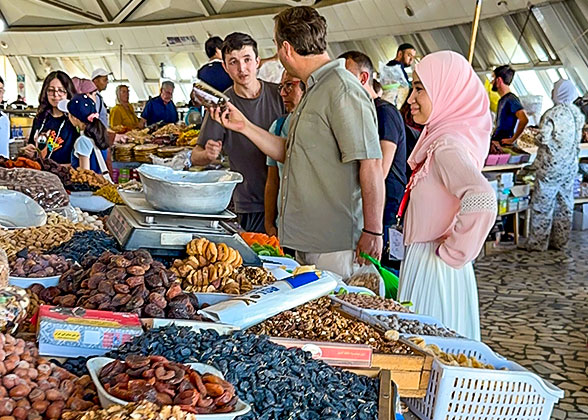
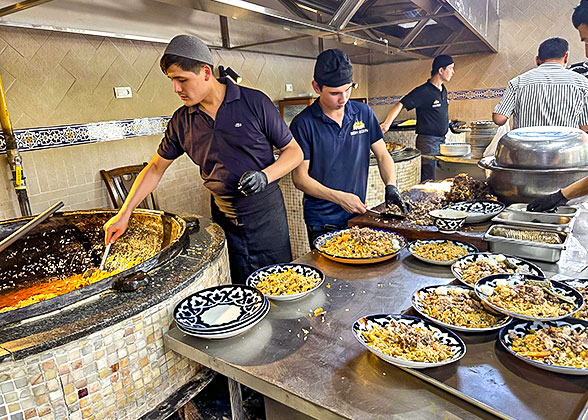
In the afternoon, visit the National Museum of Tajikistan, which preserves more than 50,000 items spanning from the Bronze Age (circa 4,000 BC) to the early 20th century, including pottery, inscribed coins, and artifacts excavated from the ancient Sogdian settlement. Then, head to the 4-hectare (10-acre) magnificent Navruz Palace, once regarded as the largest teahouse in the world, including a man-made lake, cinema, restaurants, and 12 distinct halls decorated in different Central Asian ethnic styles. The Gulistan Hall is the highlight, which was entirely constructed of wood, without any nails! Above your head, the ceilings are exquisitely painted with florals, and at the center of the hall, a 22-meter (72-foot) diameter crystal chandelier makes it even more lavish.
Finally, complete today’s itinerary by immersing yourself in authentic Tajik culture at the local bazaar. Mondays are the best time to experience the most vibrant atmosphere, echoing centuries-old traditions, as Dushanbe has hosted livestock and craft markets dating back to its small village days. When the night comes, we will transfer you to the hotel.
Meals: Breakfast
Accommodation: Hotel Atlas Dushanbe (4 stars) or similar

Local Bazaar in Dushanbe, Tajikistan

Try the Tajik Food
Day 14 Dushanbe to Kalai-Khumb: 8-Hour Drive along the M41 Pamir Highway
Today, accompanied by our driver and the guide, enjoy an unforgettable road journey along one of the world’s most epic routes, the M41 Pamir Highway, which served as a vital Silk Road corridor in the past, connecting Afghanistan, Uzbekistan, Tajikistan, and Kyrgyzstan for millennia. Paved by the Soviet Union in the 1930s, it now snakes like a grey-yellow ribbon through the stark, snow-capped peaks.
After leaving Dushanbe, we’ll drop by some small lakes, and about 1.5-2 hours later, the stunning cobalt blue expanse of Nurek Reservoir will appear. You can stop at the viewpoint to capture the panoramic vista and the surrounding ridges. Continuing eastward, we’ll ascend today’s highest point, Shuraba Pass, at an altitude of 2,000 meters (6,560 feet). Here, the strong winds carve the rock on the cliffs into various shapes. Descending from the pass, the emerald-green Panj River gradually fills your view. About 100 meters (330 feet) wide, it is the natural border between Tajikistan and Afghanistan, and you can have a glance at the scenery on the Afghan side. Keep an eye on the western side while driving along the shore so that you may see the 4,655-meter-high (15,272-foot)
Meals: Breakfast
Accommodation: Karon Palace Hotel Kalai-Khumb (4 stars) or similar
After leaving Dushanbe, we’ll drop by some small lakes, and about 1.5-2 hours later, the stunning cobalt blue expanse of Nurek Reservoir will appear. You can stop at the viewpoint to capture the panoramic vista and the surrounding ridges. Continuing eastward, we’ll ascend today’s highest point, Shuraba Pass, at an altitude of 2,000 meters (6,560 feet). Here, the strong winds carve the rock on the cliffs into various shapes. Descending from the pass, the emerald-green Panj River gradually fills your view. About 100 meters (330 feet) wide, it is the natural border between Tajikistan and Afghanistan, and you can have a glance at the scenery on the Afghan side. Keep an eye on the western side while driving along the shore so that you may see the 4,655-meter-high (15,272-foot)
Meals: Breakfast
Accommodation: Karon Palace Hotel Kalai-Khumb (4 stars) or similar
Day 15 8-Hour Drive back from Kalai-Khumb to Dushanbe
Check out of the hotel, and let’s embark on the return trip to Dushanbe via the formidable Khaburabot Pass. Rising to approximately 3,250 meters (10,660 feet), it is more precipitous than Shuraba Pass, where the car travels along the road clinging to the edge of cliffs, offering an adrenaline-fueled experience. Along the way, the landscapes shift from lakes and rivers to peaks, revealing the defining high-altitude wilderness. Rugged ridges are stained a deep Martian red, creating an atmosphere of profound and cinematic isolation. This stark beauty is punctuated by villages scattered on the slopes and herds of sheep and shaggy yaks. We’ll arrive at the city center of Dushanbe before evening. Check into the hotel and have a good rest after the two-day road trip.
Meals: Breakfast
Accommodation: Hotel Atlas Dushanbe (4 stars) or similar
Meals: Breakfast
Accommodation: Hotel Atlas Dushanbe (4 stars) or similar
Day 16 Drive to Termez, Uzbekistan, with Stopovers at Hisor Fortress and Jarkurgan Minaret
Bid farewell to Dushanbe, and our guide will whisk you away to the ancient Hisor Fortress. Constructed over 2,500 years ago, this stronghold witnessed successive conquests by Arab armies, Mongols, and Timur's forces. Passing through the brick-piled gateway and following the paths flanked by the ruins of former madrasas, mosques, and caravanserais, we will ascend the stone steps to the governor's residence on the hilltop to capture a commanding view across the fortress and surrounding valley. Sometimes, you may encounter newlywed couples holding their wedding ceremony where guests are dancing and singing to the band’s performances.
Then, you’ll be escorted to the Tajik-Uzbek border. After completing formalities, your Uzbek driver will pick you up, and you’ll proceed to the 20-meter-high (65-foot) Jarkurgan Minaret, a remarkable remnant from the Seljuk era in the early 12th century that originally stood 40 meters (130 feet) high. Its tower body is decorated with herringbone brick patterns, while the base is inscribed with the Quran. Climb up its narrow staircases to see the panoramic vistas of nearby villages and farmlands. We'll conclude the day by transferring you to the hotel in Termez for an overnight rest.
Meals: Breakfast
Accommodation: Meridian Hotel, Termez (4 stars) or similar
Then, you’ll be escorted to the Tajik-Uzbek border. After completing formalities, your Uzbek driver will pick you up, and you’ll proceed to the 20-meter-high (65-foot) Jarkurgan Minaret, a remarkable remnant from the Seljuk era in the early 12th century that originally stood 40 meters (130 feet) high. Its tower body is decorated with herringbone brick patterns, while the base is inscribed with the Quran. Climb up its narrow staircases to see the panoramic vistas of nearby villages and farmlands. We'll conclude the day by transferring you to the hotel in Termez for an overnight rest.
Meals: Breakfast
Accommodation: Meridian Hotel, Termez (4 stars) or similar
Day 17 Termez: Fayaz Tepe, Archaeology Museum, Kokildor Ota Khanaka Monastery, Fortress Kyrk-Kyz
Today, explore the highlights of Termez with our guide! Situated near the borders of Turkmenistan, Tajikistan, and Afghanistan, the city stands as a historic crossroads of Uzbek culture. Unlike other cities that are rich in Islamic culture, Termez was a major Buddhist center before being destroyed by Genghis Khan in the 13th century, and you can still see the relative archaeological treasures now.
First, head to the Buddhist temple, Fayaz Tepe. Rising from the crimson land, it is dominated by a hemispherical dome that shelters the eroded remains of the original stupa. Passing the Al-Hakim at-Termezi Mausoleum, the resting place of the revered 11th-century Islamic scholar, let’s briefly learn about the history of this old city by 27,000 artifacts in the Archaeology Museum of Termez, including a remarkable collection of ancient Buddhist sculptures, murals, ritual objects excavated from sites like Fayaz Tepe, terracotta horse figurines, and coins from the Hellenistic era (323 BC-146 BC).
Then, admire Termez’s grandest mausoleum complex, Sultan Saodat Ensemble, the burial site for royal families from the 11th to 15th centuries. Inside the hall lies a coffin draped in green cloth, which is said to be the resting place of a direct descendant of Prophet Muhammad. Nearby is the Kokildor Ota Khanaka Monastery. Some claim that the building once functioned as a hotel for pilgrims of the Sultan Saodat Ensemble during the 16th century, while others believe that it was the meditation place of Sufi master Kokildor Ota, later becoming his tomb. Nowadays, it only leaves the ornate façade, imposing arched portal, and plain white interiors inlaid with lattice windows. Today’s sightseeing will end at the Fortress Kyrk-Kyz. According to the folk narrative, forty women defended this fortress and avenged their husbands’ slaying in the 11th century; hence, it is also known as the Forty Maidens. Finally, our driver will send you back to the hotel.
Meals: Breakfast
Accommodation: Meridian Hotel, Termez (4 stars) or similar
First, head to the Buddhist temple, Fayaz Tepe. Rising from the crimson land, it is dominated by a hemispherical dome that shelters the eroded remains of the original stupa. Passing the Al-Hakim at-Termezi Mausoleum, the resting place of the revered 11th-century Islamic scholar, let’s briefly learn about the history of this old city by 27,000 artifacts in the Archaeology Museum of Termez, including a remarkable collection of ancient Buddhist sculptures, murals, ritual objects excavated from sites like Fayaz Tepe, terracotta horse figurines, and coins from the Hellenistic era (323 BC-146 BC).
Then, admire Termez’s grandest mausoleum complex, Sultan Saodat Ensemble, the burial site for royal families from the 11th to 15th centuries. Inside the hall lies a coffin draped in green cloth, which is said to be the resting place of a direct descendant of Prophet Muhammad. Nearby is the Kokildor Ota Khanaka Monastery. Some claim that the building once functioned as a hotel for pilgrims of the Sultan Saodat Ensemble during the 16th century, while others believe that it was the meditation place of Sufi master Kokildor Ota, later becoming his tomb. Nowadays, it only leaves the ornate façade, imposing arched portal, and plain white interiors inlaid with lattice windows. Today’s sightseeing will end at the Fortress Kyrk-Kyz. According to the folk narrative, forty women defended this fortress and avenged their husbands’ slaying in the 11th century; hence, it is also known as the Forty Maidens. Finally, our driver will send you back to the hotel.
Meals: Breakfast
Accommodation: Meridian Hotel, Termez (4 stars) or similar
Day 18 Drive 5-6 Hours to Shakhrisabz: Ak-Saray Palace, Kok-Gumbaz Mosque; Head to Samarkand
Bibi Khanym Mosque, Uzbekistan
The Dor-us Siodat Memorial Complex, featuring a striking conical dome, was originally built as Timur's mausoleum, but it became the grave of his two eldest sons. To its north, the remnants of Ak-Saray Palace come into view. Begun in 1380, its construction lasted for about 16 years, and it was completed with a 50-meter-high (164-foot) gate, flanked by minarets exceeding 65 meters (213 feet) high. Devastated in the 16th century, it has only the 38-meter-high (124-foot) portal standing today. Though the blue tilework has faded, the ruins still powerfully evoke the structure's original staggering scale and ambition. Then, pause at the Dor-ut Tilovat Ensemble, comprising several mosques and tombs, built to commemorate the founder of Sufism in the 14th century. Finally, conclude the Shahrisabz exploration at the Kok-Gumbaz Mosque, built in 1437 by Timur’s grandson, Ulugh Beg, who was not only an emperor but also a renowned poet. The harmonious color and intricate tile patterns of the mosque are evidence of his aesthetic sensibility.
Before dusk, the driver will transfer you to the heart of Timur’s empire, Samarkand, and you’ll stay overnight at the pre-booked hotel.
Meals: Breakfast
Accommodation: Grand Samarkand Superior (4 stars) or similar
Day 19 Samarkand: Registan Square, Bibi Khanym Mosque, Ulugh Beg Observatory, Gur-Emir Mausoleum
After breakfast, our guide will meet you at the hotel lobby and accompany you to explore Samarkand. With a history tracing back to the 6th century BC, Samarkand ranks among Central Asia’s most ancient cities, where the Sogdians, a merchant ethnic group, established their settlement and commercial hub, dominating trade routes stretching to China’s Hexi Corridor by the 4th century and reaching its zenith around 750. Successively conquered by the Arabs, Mongols, and Timur, the city boasts a layered history that is reflected in its monumental architecture.
We’ll begin at Registan Square, the city’s spiritual center, encircled by three madrasahs, among which the Ulugh Beg Madrasah was once a celestial research center, featuring a colossal portal adorned with star-shaped patterns. Roaming across the square, let’s drop by the vibrant stalls of Siyob Bazaar and behold the ribbed azure dome of Bibi Khanym Mosque to the east. Built by Timur’s wife, it was once the largest mosque in the Islamic world. Inside, you can see a huge Quran imposed on a marble stand in the courtyard, in front of which many pilgrims are praying for blessings.
Continue to the Ulugh Beg Observatory in the northern suburbs. Once, as the most advanced astronomy institution in Central Asia in the 15th century, it housed a 40-meter (131-foot) diameter marble sextant, and now only a quarter of it is preserved underground. When the sunlight pierces through the roof, you can see spots on the track. On the way back to the city center, we will pause at the Shah-i-Zinda Necropolis, whose domes resemble a sapphire necklace stretching on the slope of the hill. Served as the resting place of royal females during the Timurid era (14th-16th century), it has 11 mausoleums adorned with cobalt and lapis lazuli tiles. Finally, conclude today’s itinerary at the Gur-Emir Mausoleum, where the atrovirens jaded conifer of Timur lies beneath the starry dome.
 Recommended Restaurant (at your own expense):
Recommended Restaurant (at your own expense):
For authentic local flavor, Alibek Somsa is a beloved restaurant renowned for somsa, a kind of Uzbek pastry filled with beef, mutton, chicken, or vegetables. Hand-kneaded dough will be wrapped around minced fillings; after being brushed with yolk and sprinkled with black sesame, the parcels will be baked in a clay tandir oven. The cooked somsa is flaky outside and juicy inside. You can eat it dipped in pomodoro sauce.
Price per Somsa: UZS 10,000 (USD 0.7)
Address: JXG4+5PJ, Mironshokh Mirzo Str, Samarkand, Samarqand Region
Meals: Breakfast
Accommodation: Grand Samarkand Superior (4 stars) or similar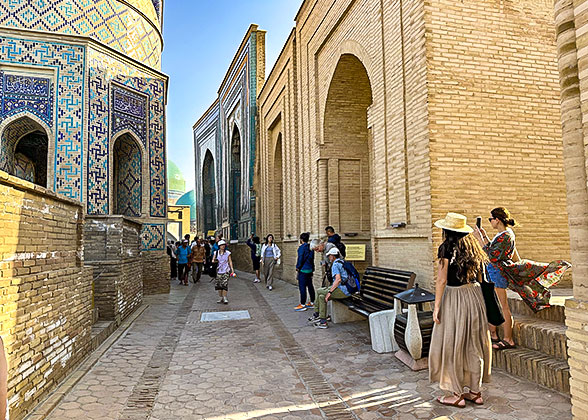
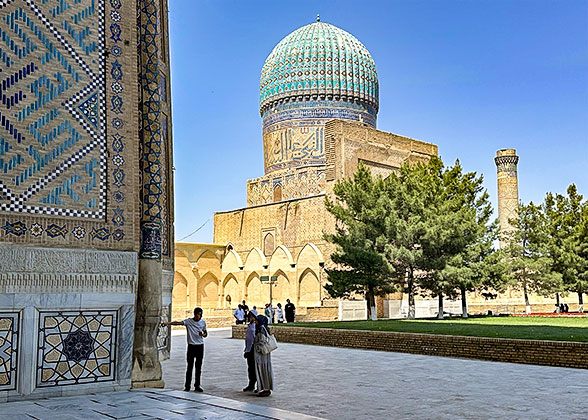
We’ll begin at Registan Square, the city’s spiritual center, encircled by three madrasahs, among which the Ulugh Beg Madrasah was once a celestial research center, featuring a colossal portal adorned with star-shaped patterns. Roaming across the square, let’s drop by the vibrant stalls of Siyob Bazaar and behold the ribbed azure dome of Bibi Khanym Mosque to the east. Built by Timur’s wife, it was once the largest mosque in the Islamic world. Inside, you can see a huge Quran imposed on a marble stand in the courtyard, in front of which many pilgrims are praying for blessings.
Continue to the Ulugh Beg Observatory in the northern suburbs. Once, as the most advanced astronomy institution in Central Asia in the 15th century, it housed a 40-meter (131-foot) diameter marble sextant, and now only a quarter of it is preserved underground. When the sunlight pierces through the roof, you can see spots on the track. On the way back to the city center, we will pause at the Shah-i-Zinda Necropolis, whose domes resemble a sapphire necklace stretching on the slope of the hill. Served as the resting place of royal females during the Timurid era (14th-16th century), it has 11 mausoleums adorned with cobalt and lapis lazuli tiles. Finally, conclude today’s itinerary at the Gur-Emir Mausoleum, where the atrovirens jaded conifer of Timur lies beneath the starry dome.
For authentic local flavor, Alibek Somsa is a beloved restaurant renowned for somsa, a kind of Uzbek pastry filled with beef, mutton, chicken, or vegetables. Hand-kneaded dough will be wrapped around minced fillings; after being brushed with yolk and sprinkled with black sesame, the parcels will be baked in a clay tandir oven. The cooked somsa is flaky outside and juicy inside. You can eat it dipped in pomodoro sauce.
Price per Somsa: UZS 10,000 (USD 0.7)
Address: JXG4+5PJ, Mironshokh Mirzo Str, Samarkand, Samarqand Region
Meals: Breakfast
Accommodation: Grand Samarkand Superior (4 stars) or similar

Shah-i-Zinda Necropolis, Samarkand

Bibi Khanym Mosque
Day 20 High-speed Train to Bukhara; Visit Kalyan Minaret, Magoki-Attori Mosque, Lyabi Hauz Ensemble
The driver will escort you to the train station in the morning, where you will jump on a 2-hour high-speed train to Bukhara, a 2,600-year-old city rising from the desert. As a pivotal Silk Road nexus, it is a magnet for travelers, pilgrims, and Islamic scholars for the profound convergence of Zoroastrianism, Christianity, Judaism, Buddhism, and Islam.
Upon arrival, our local driver will transfer you to the hotel for check-in. After a brief respite, the Bukhara adventure starts. The first stop will be the iconic Kalyan Minaret, which is said to have awed Genghis Khan. Gaze upward at its honeycomb-like brickwork at the top, where sunlight casts a symphony of shadows and highlights on its surface. Peek at the adjacent Kalyan Mosque, the second-biggest mosque of Central Asia, and Miri-Arab Madrasah, the Islamic education center of Bukhara, and we will discover Central Asia’s oldest mosque, Magoki-Attori Mosque, constructed in 714. According to a local legend, the mosque was buried underground when Genghis Khan conquered Bukhara in the 13th century and thus survived the destruction. A thousand years later, it comes to light, revealing faded grandeur through remaining turquoise tile fragments and carved stucco reliefs on the portal. Now, the mosque houses a small carpet museum showcasing exquisite hand-woven rugs adorned with suzani embroideries.
Passing the Ulugh Beg Madrasah and Abdulaziz Khan Madrasah, outstanding for their cobalt-blue geometric tile facades, let’s wander through the bustling Trade Dome Market and have a short break by the pool of the Lyabi Hauz Ensemble. This plaza, shaded by mulberry trees, was a vital caravans’ stopover in the past; today, religious buildings blend with cafes and restaurants, offering a pleasant place for relaxation. Walking around, you can spot the statue of the saint Hoja Nasruddin astride his donkey nearby. Our last destination will be the Chor-Minor Madrasah, famous for the four blue-domed towers. If interested, you can climb to the central dome for a closer view of the distinctive decorative motifs on each tower as well as a panoramic view of the surrounding blocks. Finally, the driver will send you back to the hotel.
Meals: Breakfast
Accommodation: Volida Hotel Bukhara (3 stars) or similar
Upon arrival, our local driver will transfer you to the hotel for check-in. After a brief respite, the Bukhara adventure starts. The first stop will be the iconic Kalyan Minaret, which is said to have awed Genghis Khan. Gaze upward at its honeycomb-like brickwork at the top, where sunlight casts a symphony of shadows and highlights on its surface. Peek at the adjacent Kalyan Mosque, the second-biggest mosque of Central Asia, and Miri-Arab Madrasah, the Islamic education center of Bukhara, and we will discover Central Asia’s oldest mosque, Magoki-Attori Mosque, constructed in 714. According to a local legend, the mosque was buried underground when Genghis Khan conquered Bukhara in the 13th century and thus survived the destruction. A thousand years later, it comes to light, revealing faded grandeur through remaining turquoise tile fragments and carved stucco reliefs on the portal. Now, the mosque houses a small carpet museum showcasing exquisite hand-woven rugs adorned with suzani embroideries.
Passing the Ulugh Beg Madrasah and Abdulaziz Khan Madrasah, outstanding for their cobalt-blue geometric tile facades, let’s wander through the bustling Trade Dome Market and have a short break by the pool of the Lyabi Hauz Ensemble. This plaza, shaded by mulberry trees, was a vital caravans’ stopover in the past; today, religious buildings blend with cafes and restaurants, offering a pleasant place for relaxation. Walking around, you can spot the statue of the saint Hoja Nasruddin astride his donkey nearby. Our last destination will be the Chor-Minor Madrasah, famous for the four blue-domed towers. If interested, you can climb to the central dome for a closer view of the distinctive decorative motifs on each tower as well as a panoramic view of the surrounding blocks. Finally, the driver will send you back to the hotel.
Meals: Breakfast
Accommodation: Volida Hotel Bukhara (3 stars) or similar
Day 21 Bukhara: Ark Fortress, Bolo Hauz Mosque, Chashma Ayub Mausoleum, Summer Palace
The guide will accompany you to continue exploring Bukhara. First, pass through the rammed-earth walls into Bukhara’s oldest citadel, Ark Fortress, which was initially constructed in the 1st century BC and repeatedly destroyed and rebuilt over millennia, forming a bastion on a 20-meter-high (65-foot) mound. Stepping inside, you can discover old manuscripts of the Quran, ancient weaponry, Sogdian-era coins, and ceramics in the small museum. Ascend the rugged rampart after traversing the courtyards and former dungeons to capture a 360-degree view of the city.
Southeast of the Ark, the Bolo Hauz Mosque will captivate you with its 20 intricately carved columns. At the adjacent pool, position your camera level with the water surface to snap both the pillars and their reflections. After admiring the delicate brickwork of the Samnid Mausoleum and the water supply museum, which introduces the water supply system from the past to the present at the Chashma Ayub Mausoleum, continue the journey to the Summer Palace (Sitorai Mohi Hosa), the residence of Bukhara’s last emir. The White Palace is the most eye-catching with its neoclassical facades and opulent miniature interior decorations. Inside, the preserved jewelry, silk carpets, musical instruments, and porcelain from China and Japan will feast your eyes. The Bukhara itinerary will end at the Memorial Complex of Bahouddin Naqshbandi, a pilgrimage site to commemorate the 14th-century Sufi saint, composed of a Sufi lodge, a mosque, and a necropolis. The driver will transfer you to the hotel before nightfall.
 Recommended Restaurant (at your own expense):
Recommended Restaurant (at your own expense):
After weeks of Central Asian cuisine, do you miss the food from your home country? Bella Italia offers authentic Western food. The steak, pasta of different flavors, salad, and cream soup are all popular among locals and travelers. Sometimes there will be a live music show at night.
Average Cost per Person: UZS 140,000 (USD 11)
Address: B. Nakshbandi str. 125, Bukhara
Meals: Breakfast
Accommodation: Volida Hotel Bukhara (3 stars) or similar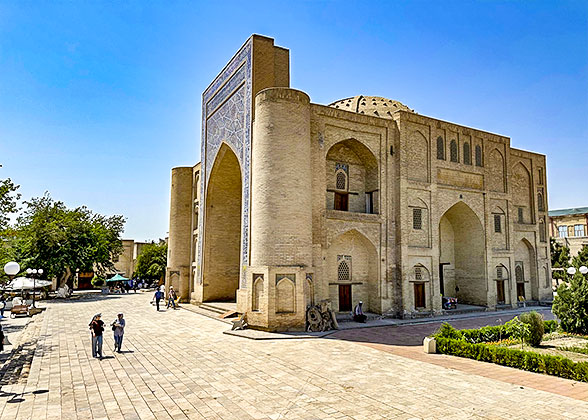

Southeast of the Ark, the Bolo Hauz Mosque will captivate you with its 20 intricately carved columns. At the adjacent pool, position your camera level with the water surface to snap both the pillars and their reflections. After admiring the delicate brickwork of the Samnid Mausoleum and the water supply museum, which introduces the water supply system from the past to the present at the Chashma Ayub Mausoleum, continue the journey to the Summer Palace (Sitorai Mohi Hosa), the residence of Bukhara’s last emir. The White Palace is the most eye-catching with its neoclassical facades and opulent miniature interior decorations. Inside, the preserved jewelry, silk carpets, musical instruments, and porcelain from China and Japan will feast your eyes. The Bukhara itinerary will end at the Memorial Complex of Bahouddin Naqshbandi, a pilgrimage site to commemorate the 14th-century Sufi saint, composed of a Sufi lodge, a mosque, and a necropolis. The driver will transfer you to the hotel before nightfall.
After weeks of Central Asian cuisine, do you miss the food from your home country? Bella Italia offers authentic Western food. The steak, pasta of different flavors, salad, and cream soup are all popular among locals and travelers. Sometimes there will be a live music show at night.
Average Cost per Person: UZS 140,000 (USD 11)
Address: B. Nakshbandi str. 125, Bukhara
Meals: Breakfast
Accommodation: Volida Hotel Bukhara (3 stars) or similar

Magoki-Attori Mosque, Bukhara

Ark Fortress
Day 22 Cross Border to Mary, Turkmenistan; Visit Ancient Merv; Fly to Ashgabat
The driver will lead you to the Uzbek-Turkmen border. After the formalities process, the Turkmenistan guide and the private driver will transfer you directly to the UNESCO-listed Ancient Merv. Emerging in the 3rd century BC, it once flourished as a global metropolis on the Silk Road and became one of the world’s largest cities by the 12th century. But its tragic end came in the 13th century when Genghis Khan massacred its citizens, razed its walls, and reduced this legendary center to ruins.
When entering the city, you’ll be caught by the 38-meter-high (125-foot) dome of the Sultan Sanjar Mausoleum. The entire cubic sanctuary was originally clad in turquoise tiles but was desquamated over time, leaving only the brickwork glowing with a honey-gold patina under the sky. Then, pass the Mohammed bin Said Mausoleum, where the Prophet’s head was found after a fight against the Arabs, and finally, explore the Kesk Fortresses, the royal residences in the 9th-13th centuries. Wandering in the shade of their broken walls, you can have a glimpse of the original layout and medieval urban life.
►Tip: As there are almost no trees that provide shade during midday in Ancient Merv, please prepare sun-protective gear and drinking water to avoid heatstroke.
In the afternoon, you’ll be transferred to Mary Airport to catch a flight to Ashgabat, the capital of Turkmenistan. Get out of the airport, and our local guide and the driver will send you to the handpicked hotel. On the way, you will be surprised to find that the buildings and vehicles in the city are nearly all white. After check-in, please have a good rest and prepare for the next day's exploration.
 Turkmenistan Travel Notes:
Turkmenistan Travel Notes:
1. Internet Access: Applications or platforms, including Instagram, WhatsApp, Facebook, and YouTube, cannot be used in Turkmenistan, and most VPN operators do not offer services in this desert country. TM Cell SIM card is the only mobile operator, but it is quite expensive to buy a SIM card at USD 38 and a 2 GB data package for USD 22.
2. Visa Requirements: Visas are mandatory for all travelers. You need to hold a Letter of Invitation (LOI) from a state-licensed tour operator to apply for a visa at the local Turkmenistan Embassy. It takes 2 months from applying for the LOI to getting a visa, so it is advisable to book your itinerary 3 months in advance.
3. Payment: Turkmenistan Manat (TMT) cash is the king, which can only be exchanged using US dollar cash, so please make sure you bring sufficient US dollars.
Meals: Breakfast
Accommodation: Sport Hotel Ashgabat (4 stars) or similar
When entering the city, you’ll be caught by the 38-meter-high (125-foot) dome of the Sultan Sanjar Mausoleum. The entire cubic sanctuary was originally clad in turquoise tiles but was desquamated over time, leaving only the brickwork glowing with a honey-gold patina under the sky. Then, pass the Mohammed bin Said Mausoleum, where the Prophet’s head was found after a fight against the Arabs, and finally, explore the Kesk Fortresses, the royal residences in the 9th-13th centuries. Wandering in the shade of their broken walls, you can have a glimpse of the original layout and medieval urban life.
►Tip: As there are almost no trees that provide shade during midday in Ancient Merv, please prepare sun-protective gear and drinking water to avoid heatstroke.
In the afternoon, you’ll be transferred to Mary Airport to catch a flight to Ashgabat, the capital of Turkmenistan. Get out of the airport, and our local guide and the driver will send you to the handpicked hotel. On the way, you will be surprised to find that the buildings and vehicles in the city are nearly all white. After check-in, please have a good rest and prepare for the next day's exploration.
1. Internet Access: Applications or platforms, including Instagram, WhatsApp, Facebook, and YouTube, cannot be used in Turkmenistan, and most VPN operators do not offer services in this desert country. TM Cell SIM card is the only mobile operator, but it is quite expensive to buy a SIM card at USD 38 and a 2 GB data package for USD 22.
2. Visa Requirements: Visas are mandatory for all travelers. You need to hold a Letter of Invitation (LOI) from a state-licensed tour operator to apply for a visa at the local Turkmenistan Embassy. It takes 2 months from applying for the LOI to getting a visa, so it is advisable to book your itinerary 3 months in advance.
3. Payment: Turkmenistan Manat (TMT) cash is the king, which can only be exchanged using US dollar cash, so please make sure you bring sufficient US dollars.
Meals: Breakfast
Accommodation: Sport Hotel Ashgabat (4 stars) or similar
Day 23 Ashgabat: National Museum, Ancient Nisa; Drive to Darvaza Gas Crater
Follow the guide’s steps to explore Ashgabat. Stroll through the paths in Independence Park and stop at the base of the 118-meter (387-foot) high Independence Monument. Leaving the park along the avenue flanked by trees planted by the visiting heads of state, you’ll be led to the National Museum of Turkmenistan, which houses more than 20,000 relics from 50,000 BC to 651. The centerpiece is the Ivory Rhyton excavated from Ancient Nisa, which is carved from a whole tusk, adorned with floral reliefs on the body, griffin head figures at the tip, and bas-reliefs of the Twelve Olympian gods at the base. In addition, you can learn about Turkmen culture by viewing the traditional carpets and ethnic costumes.
Then, drop by the Turkmenbashi Mosque-Mausoleum, Ashgabat’s grandest religious building, which is so pure with a white façade and golden domes. Continue to proceed to Ancient Nisa, the capital of the Parthian Empire (247 BC-224), 15 kilometers (9 miles) west of Ashgabat. Though the original houses, housewares, and temples are weathered, the foundations still demonstrate the city’s layout. If you happen to visit the ruins during spring (March-May), the top of the ramparts and both sides of the alleys will be covered with weeds; hence, the rammed-earth walls look like fluffy bread topped with matcha powder. You can climb up the ramparts or to the hill slope nearby to see the green carpet-like grassland dotted with red flowers, a solace for the decadent of the kingdom.
Finally, we will venture deep into the desert to the Darvaza Gas Crater, with stopovers at the Mud and Water craters on the way. This 70-meter-wide (230-foot) pit was formed in 1971 during Soviet geological prospecting. Though the flame is not as intense as before, the heat is still scorching, so please keep a safe distance while admiring it. As night falls, the crater seems to become a devil’s eye blinking in the dark world. We will enjoy a BBQ dinner near the pit, during which you can take your once-in-a-lifetime photos with the backdrop of the stark desert and orange flames. After the binge, have a good rest at the yurt camp.
Meals: Breakfast, BBQ Dinner
Accommodation: Yurt Camp, Darvaza
Then, drop by the Turkmenbashi Mosque-Mausoleum, Ashgabat’s grandest religious building, which is so pure with a white façade and golden domes. Continue to proceed to Ancient Nisa, the capital of the Parthian Empire (247 BC-224), 15 kilometers (9 miles) west of Ashgabat. Though the original houses, housewares, and temples are weathered, the foundations still demonstrate the city’s layout. If you happen to visit the ruins during spring (March-May), the top of the ramparts and both sides of the alleys will be covered with weeds; hence, the rammed-earth walls look like fluffy bread topped with matcha powder. You can climb up the ramparts or to the hill slope nearby to see the green carpet-like grassland dotted with red flowers, a solace for the decadent of the kingdom.
Finally, we will venture deep into the desert to the Darvaza Gas Crater, with stopovers at the Mud and Water craters on the way. This 70-meter-wide (230-foot) pit was formed in 1971 during Soviet geological prospecting. Though the flame is not as intense as before, the heat is still scorching, so please keep a safe distance while admiring it. As night falls, the crater seems to become a devil’s eye blinking in the dark world. We will enjoy a BBQ dinner near the pit, during which you can take your once-in-a-lifetime photos with the backdrop of the stark desert and orange flames. After the binge, have a good rest at the yurt camp.
Meals: Breakfast, BBQ Dinner
Accommodation: Yurt Camp, Darvaza
Day 24 Darvaza Gas Crater - Kunya-Urgench; Cross Border to Khiva, Uzbekistan
As dawn gilds the desert, we will journey northward for 4 hours to Kunya-Urgench, the former capital of the Khwarezm Empire (11th-13th century). Though it was abandoned after being destroyed by the Mongols in 1221, its ruins whisper tales of medieval grandeur.
With the accompaniment of our guide, let’s first pay homage to the Nedjmeddin Kubra Mausoleum, which was built to honor the 12th-century Sufi saint who perished defending against Genghis Khan’s forces. To its south stands the hexagonal Turabek Khanum Mausoleum, considered the most elegant architecture in Kunya-Urgench. Stepping inside and gazing up, you’ll be staggered by the vault adorned with patterns of stars and flowers. Passing by the Mamun Minaret, which has collapsed after centuries of earthquakes and left only a base, let’s stop at the 60-meter-high (197-foot) Kutlug Timur Minaret. Looking up, you will find that it is slightly tilted. The decorative bands are weathered, but the Islamic calligraphy is still visible. Nearby, the II Arslan Mausoleum will intrigue you with its 12-faceted conical dome and exquisite floral stucco reliefs on the exterior walls. Your Turkmenistan tour will be concluded at the Kyrkmolla Mausoleum, the heart of ancient Kunya-Urgench, where you may see some women draped in carpets rolling down the slope to gain the blessing of God.
In the afternoon, the Turkmenistan guide and the driver will transfer you to the border, where our Uzbek driver will pick you up and escort you to Khiva.
Meals: Breakfast
Accommodation: Hotel Asia Khiva (3 stars) or similar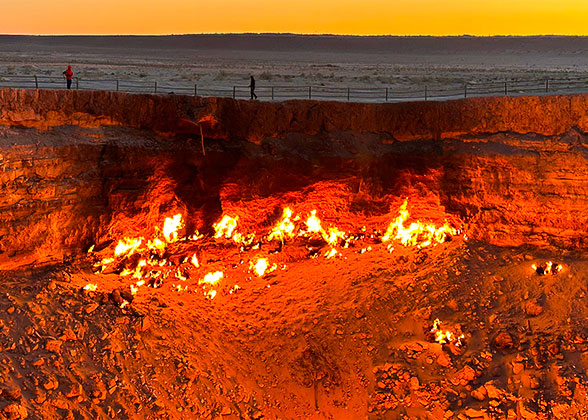
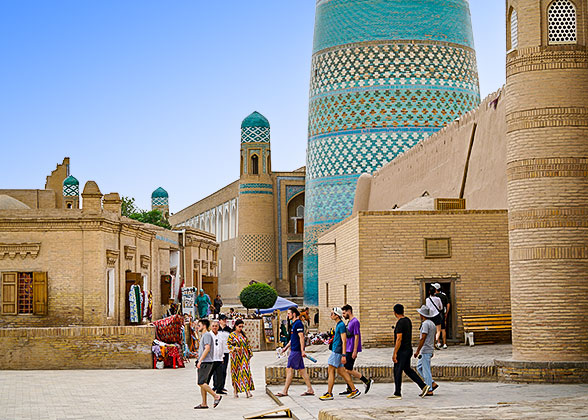
With the accompaniment of our guide, let’s first pay homage to the Nedjmeddin Kubra Mausoleum, which was built to honor the 12th-century Sufi saint who perished defending against Genghis Khan’s forces. To its south stands the hexagonal Turabek Khanum Mausoleum, considered the most elegant architecture in Kunya-Urgench. Stepping inside and gazing up, you’ll be staggered by the vault adorned with patterns of stars and flowers. Passing by the Mamun Minaret, which has collapsed after centuries of earthquakes and left only a base, let’s stop at the 60-meter-high (197-foot) Kutlug Timur Minaret. Looking up, you will find that it is slightly tilted. The decorative bands are weathered, but the Islamic calligraphy is still visible. Nearby, the II Arslan Mausoleum will intrigue you with its 12-faceted conical dome and exquisite floral stucco reliefs on the exterior walls. Your Turkmenistan tour will be concluded at the Kyrkmolla Mausoleum, the heart of ancient Kunya-Urgench, where you may see some women draped in carpets rolling down the slope to gain the blessing of God.
In the afternoon, the Turkmenistan guide and the driver will transfer you to the border, where our Uzbek driver will pick you up and escort you to Khiva.
Meals: Breakfast
Accommodation: Hotel Asia Khiva (3 stars) or similar

Darvaza Gas Crater, Turkmenistan

Kalta Minor, Khiva, Uzbekistan
Day 25 Khiva: Kalta Minor Minaret, Tosh-Khovli Palace, Kunya-Ark; Fly to Tashkent
After breakfast, you will embark on a Khiva sightseeing tour with our local guide. Early in the 4th century, Sogdian merchants established Khiva as a knot on the Silk Road, linking Urgench, Bukhara, and Samarkand, where caravans exchanged Chinese silk, Indian spices, and Persian metalwork. Its golden age dawned in the 16th century as the capital of the Khivan Khanate after being ravaged by Genghis Khan and Timur. But by then, authentic Sogdian culture had fused with Turkic-Persian influences, leaving numerous medieval Islamic monuments preserved in Khiva’s inner city, Ichan Kala, the UNESCO World Heritage site you will visit today.
Kalta Minor Minaret is considered one of the most iconic buildings in Khiva, whose fat and cylindrical body is conspicuous from afar. It was said that this cobalt-blue tower was planned to be built 70 meters (230 feet) high, and was abandoned after the Khan’s assassination. Behind the tower stands the Muhammad Aminkhan Madrasah, once Khiva’s richest Islamic institution, which is now renovated to comprise a hotel and a café. Opposite is the Muhammad Rahim Khan Madrasah, the largest Islamic school in 1876. After being restored in 1992, it has become a museum showcasing the history of the Khivan Khanate and the life story of its ruler, Mohammed Rakhim Khan.
Then, enter the 10th-century Juma Mosque to admire the 218 hand-carved cedar columns from the 10th century. Wander through the alley and enter the Tosh-Hovli Palace, the khan's residence in the 19th century, which will amaze you with ceramic mosaic courtyards, delicate stone pillars, and gilded ceiling muqarnas. After showing your respects to Pahlavan Mahmud, a poet, wrestler, and epitome of chivalry in the 12th-13th centuries, at the Pahlavan Mahmud Mausoleum, gaze up at Khiva’s tallest structure, the Islam Khoja Minaret, soaring at 57 meters (187 feet).
Finally, unveil the story of the Sogdians in the Kunya-Ark, a 17th-century citadel that comprises mosques, a reception hall, harems, mints, stalls, and prisons. In its small museum, you can view Sogdian coins and the Timurid-era (14th-16th century) weaponry. Ascend the rampart, and the ochre cityscape will unfold like a tapestry embroidered with geometric patterns, with the silver ribbon-like Amu Darya River shimmering in the distance.
At the end of today’s itinerary, the driver will whisk you away to Urgench Airport for a 1.5-hour flight to Tashkent. Upon landing, the Tashkent driver will escort you to the hotel for check-in.
Meals: Breakfast
Accommodation: Wyndham Tashkent (4 stars) or similar
Kalta Minor Minaret is considered one of the most iconic buildings in Khiva, whose fat and cylindrical body is conspicuous from afar. It was said that this cobalt-blue tower was planned to be built 70 meters (230 feet) high, and was abandoned after the Khan’s assassination. Behind the tower stands the Muhammad Aminkhan Madrasah, once Khiva’s richest Islamic institution, which is now renovated to comprise a hotel and a café. Opposite is the Muhammad Rahim Khan Madrasah, the largest Islamic school in 1876. After being restored in 1992, it has become a museum showcasing the history of the Khivan Khanate and the life story of its ruler, Mohammed Rakhim Khan.
Then, enter the 10th-century Juma Mosque to admire the 218 hand-carved cedar columns from the 10th century. Wander through the alley and enter the Tosh-Hovli Palace, the khan's residence in the 19th century, which will amaze you with ceramic mosaic courtyards, delicate stone pillars, and gilded ceiling muqarnas. After showing your respects to Pahlavan Mahmud, a poet, wrestler, and epitome of chivalry in the 12th-13th centuries, at the Pahlavan Mahmud Mausoleum, gaze up at Khiva’s tallest structure, the Islam Khoja Minaret, soaring at 57 meters (187 feet).
Finally, unveil the story of the Sogdians in the Kunya-Ark, a 17th-century citadel that comprises mosques, a reception hall, harems, mints, stalls, and prisons. In its small museum, you can view Sogdian coins and the Timurid-era (14th-16th century) weaponry. Ascend the rampart, and the ochre cityscape will unfold like a tapestry embroidered with geometric patterns, with the silver ribbon-like Amu Darya River shimmering in the distance.
At the end of today’s itinerary, the driver will whisk you away to Urgench Airport for a 1.5-hour flight to Tashkent. Upon landing, the Tashkent driver will escort you to the hotel for check-in.
Meals: Breakfast
Accommodation: Wyndham Tashkent (4 stars) or similar
Day 26 Tashkent: Chorsu Bazaar, State Museum of Applied Art, Tashkent Metro; Airport See-off
Take your last day to dive deep into the most dynamic metropolis of Central Asia, Tashkent. The guide will first lead you to the Khast-Imam Complex, the city’s spiritual nucleus, which is framed by two Islamic schools, a mosque, and a mausoleum. To the south, the huge blue and green dome of the Chorsu Bazaar will come into your view. Peruse stalls arranged in concentric circles to smell the aroma of spices, listen to vendors' calls, and capture the kaleidoscopic scene from the upper floor. At the open-air section, savor sizzling kebab and fresh-baked Uzbek Obi non bread, and admire vibrant handicrafts, such as suzani embroideries, wooden carvings, and pottery.
Jostling out of the bustling market, we will step into the State Museum of Applied Art, housed in a 19th-century merchant's residence, which is a repository of Uzbek craftsmanship, conserving Rishtan's cobalt ceramics, Fergana's ikat silks, and Samarkand's gold-thread embroidery. Besides dizzying exhibits, the building itself is also an artwork, whose mosaic façade, exquisite niches, and garish ceilings are photographic. Afterward, be wowed by Tashkent’s ornate Soviet metro stations. Designed in different styles, some stations feature remarkably huge vaults, some are futuristic, while some resemble European palaces. We will get off at the Independence Square station and walk to the adjacent Amir Timur Square. Our Tashkent tour will end at the poignant Earthquake Memorial, honoring the 300,000 lives lost in the 1966 disaster.
Your “five stans” journey will conclude when the driver escorts you to the airport and sees you off. Should you want to dig deeper into the history of the Silk Road? We can extend your Central Asia tour packages to its easternmost starting point in Xi’an, China. Or if you want to set your footprints in other parts of Asia, we can tailor the trip to Mongolia, Japan, or Thailand. Contact us at any time, and our travel specialists await your inquiry!
Meals: Breakfast
Jostling out of the bustling market, we will step into the State Museum of Applied Art, housed in a 19th-century merchant's residence, which is a repository of Uzbek craftsmanship, conserving Rishtan's cobalt ceramics, Fergana's ikat silks, and Samarkand's gold-thread embroidery. Besides dizzying exhibits, the building itself is also an artwork, whose mosaic façade, exquisite niches, and garish ceilings are photographic. Afterward, be wowed by Tashkent’s ornate Soviet metro stations. Designed in different styles, some stations feature remarkably huge vaults, some are futuristic, while some resemble European palaces. We will get off at the Independence Square station and walk to the adjacent Amir Timur Square. Our Tashkent tour will end at the poignant Earthquake Memorial, honoring the 300,000 lives lost in the 1966 disaster.
Your “five stans” journey will conclude when the driver escorts you to the airport and sees you off. Should you want to dig deeper into the history of the Silk Road? We can extend your Central Asia tour packages to its easternmost starting point in Xi’an, China. Or if you want to set your footprints in other parts of Asia, we can tailor the trip to Mongolia, Japan, or Thailand. Contact us at any time, and our travel specialists await your inquiry!
Meals: Breakfast
Expand All
Collapse All
This trip can be customized to meet your individual needs!
Itineraries you may also like:
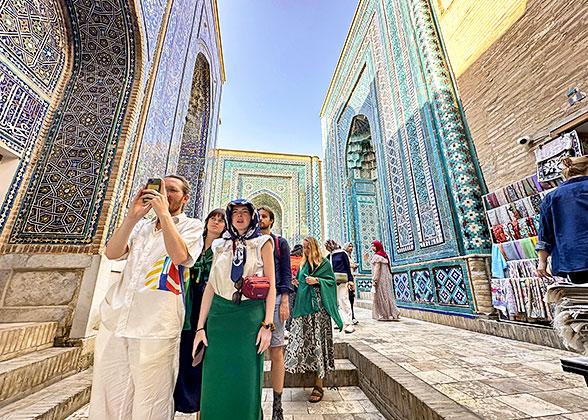 8 Days Tashkent - Samarkand - Bukhara - Kyzylkum Desert - Khiva - Urgench - Tashkent from USD1319
8 Days Tashkent - Samarkand - Bukhara - Kyzylkum Desert - Khiva - Urgench - Tashkent from USD1319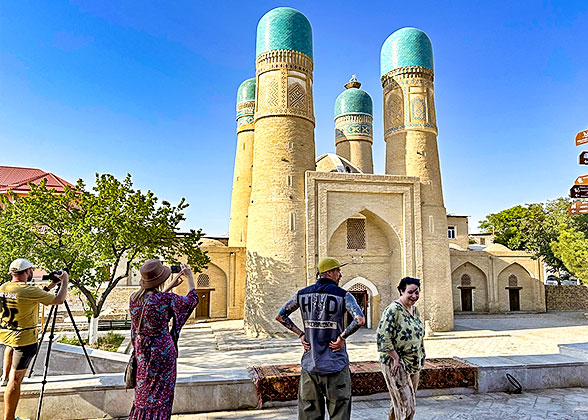 10 Days Tashkent - Urgench - Khiva - Kyzylkum Desert - Bukhara - Nurata - Safari Yurt Camp - Samarkand - Tashkent from USD1539
10 Days Tashkent - Urgench - Khiva - Kyzylkum Desert - Bukhara - Nurata - Safari Yurt Camp - Samarkand - Tashkent from USD1539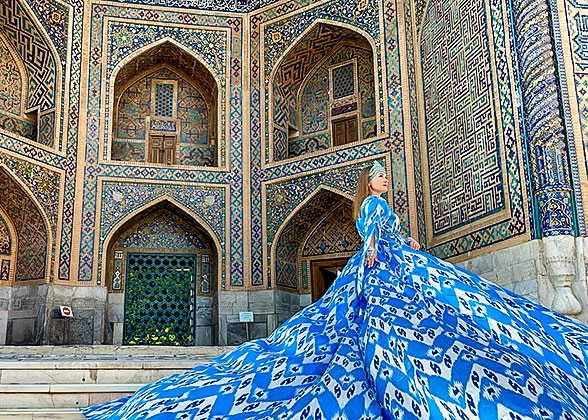 11 Days Tashkent - Nukus - Muynak - Nukus - Khiva - Kyzylkum Desert - Bukhara - Shakhrisabz - Samarkand - Tashkent from USD1803
11 Days Tashkent - Nukus - Muynak - Nukus - Khiva - Kyzylkum Desert - Bukhara - Shakhrisabz - Samarkand - Tashkent from USD1803
